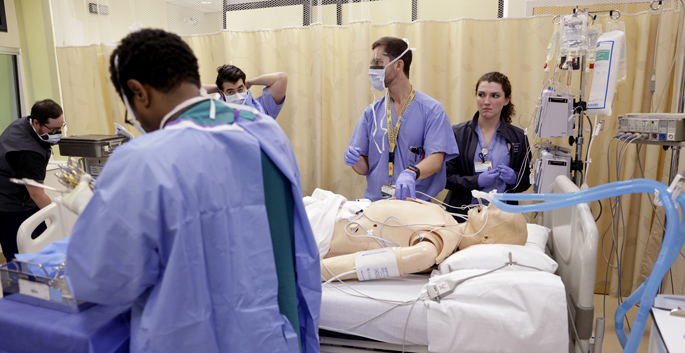
A multidisciplinary team including more than a dozen nurses, critical care anesthesiologists and cardiac surgeons recently collaborated on a live simulation to develop a new protocol for a rare but high-stakes cardiothoracic event — when a team has to perform a re-sternotomy at a patient’s bedside as a lifesaving measure.
When the life-or-death situation occurs, surgery must be performed immediately at the bedside without the usual specialized team and equipment because there is no time to get to an operating room.
The Society of Thoracic Surgeons has previously issued recommendations for the cardiothoracic advanced life support (CALS) protocol, and this was the first time the Cardiovascular Intensive Care Unit (CVICU) team at Vanderbilt University Hospital has practiced the scenario in a high-fidelity simulation, said Jessica Williams, RN, CCRN, CVICU program coordinator.
The team practiced simulations in a cadaver lab, then on mannequins in the Center for Experiential Learning and Assessment lab in Light Hall. The goal was to become more familiar with the scenario and better define roles in such situations, Williams said.
“Bedside re-sternotomies occur about a dozen times a year, so it’s a low-frequency, high-risk event, lending itself to chaos,” she said. “It really takes the collaboration of the whole team to make it run successfully and smoothly.”
The demonstration on cadavers and mannequins allowed the team to work through a scenario together, ask questions and debrief in an unhurried environment in which a human life is not at stake. By doing so, they are better prepared for the real situation.
Jeremy Walco, MD, assistant professor of Anesthesiology, recalls being in that situation quite a few times. “Often a patient becomes very unstable very quickly,” he said. “There’s often not a lot of time to react.”
Developing a new protocol and creating set standards “really helps to streamline it and helps to standardize what happens when those situations do arise,” added John Trahanas, MD, assistant professor of Cardiac Surgery. “We’re incredibly fortunate to have access to a simulation lab like this where we can reproduce a very realistic scenario.”
Antonio Hernandez, MD, MSCI, professor of Anesthesiology and co-medical director of the CVICU, described the protocol as aiming to improve the survival rates for patients in the scenario.
“I think what’s unique about this opportunity is that it brings a multidisciplinary team of people who are managing acute patients 24/7 together at the table,” he said. “We have nursing and ICU staff, but we need to incorporate a very important member of the team, our advanced practice providers. What we hope to gain is a more prompt and organized response to restoring systemic circulation for a patient.”
The scenario aimed to bring all the people to the table who would work at the bedside in such a situation. One major player is the nurse — and JoAnna Bentsen, RN, CCRN, nursing education specialist for the CVICU, was on hand to integrate the lessons learned into her educational program.
“What I saw today was a lot of listening,” Bentsen said. “To have all those people listening makes everybody feel good about the experience.”















